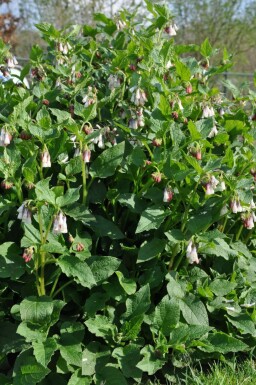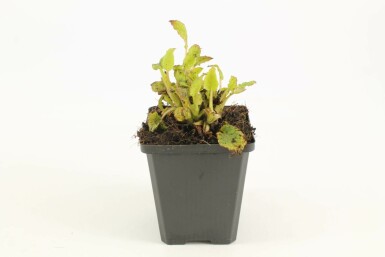

40cm



At Heijnen Plants, we take pride in offering a diverse range of flora, including the Symphytum, known commonly as comfrey. This herbaceous perennial, native to the Caucasus, is recognized for its lush green foliage and bell-shaped flowers that come in shades of yellow and white. Valued for its ability to enhance soil fertility, comfrey is not just visually appealing but also beneficial for your garden ecosystem. While it may not be evergreen or fragrant, the resilience and the ease with which it can be integrated into a variety of garden designs make Symphytum a favored choice for gardeners seeking both beauty and function in their planting schemes.


40cm



Discover the diverse genus Symphytum, commonly referred to as comfrey. This group of plants is renowned for its widespread creeping growth habit and its traditional use in gardens for centuries. Originating from the lush regions of the Caucasus, Symphytum has adapted to various environments, making it a versatile addition to any border or group planting scheme.
With a charming array of flower colors that emerge in the spring, ranging from red to cream, and a consistent verdant foliage throughout the growing seasons, Symphytum adds both aesthetic appeal and functionality to gardens. Its resilience and ease of cultivation have solidified its popularity among gardeners and plant enthusiasts alike.
Symphytum is a noteworthy genus for several reasons, making it an excellent candidate for gardeners looking to enrich their outdoor spaces:
When integrating Symphytum into your garden, consider these tips to ensure the plants flourish:
Embrace the unassuming charm of comfrey, a plant that graces the garden with clusters of bell-shaped flowers and a lush, verdant presence. Symphytum grandiflorum, in particular, boasts a robust disposition and an ability to thrive in a variety of soil conditions, making it a delightful and low-maintenance choice for gardeners seeking both beauty and practicality.
We would like to provide some tips on how to plant and care for a Symphytum. By following these tips, you can be sure to enjoy your Symphytum for a long time.
For optimal growth, Symphytum should be situated in a sunny location, where its vibrant spring and summer blossoms of red and cream can develop to their full potential. While this species can adapt to various soil conditions, it thrives best in well-drained soil, ensuring that its roots remain healthy without becoming waterlogged. Given its creeping growth habit and moderate height of approximately 40 cm, it serves as an excellent choice for bordering or group plantings, where its lush green foliage can spread gracefully. Adequate watering should be maintained to support its average water needs, particularly since it is not drought-resistant.
For optimal growth, Symphytum thrives in well-drained soil and benefits from exposure to full sunlight. To plant, prepare a hole that comfortably accommodates the pot's size, ensuring the root ball is level with the soil surface. Gently remove the plant from its pot and place it into the hole. Backfill with soil, pressing down firmly to eliminate air pockets and to secure the plant in place. Water moderately to settle the soil around the roots and maintain an average watering schedule to support establishment. This species, while not evergreen, will return each year with a fresh display of foliage and blooms.
To ensure the Symphytum thrives and displays its full spectrum of red and cream blossoms during its flowering period, a balanced approach to fertilization is beneficial. Apply a general-purpose fertilizer early in the growing season, as new foliage begins to emerge. This will give the plant a boost of nutrients, aiding in the establishment of its lush, green foliage and support for its creeping widespread growth habit.
A second application of fertilizer can be beneficial just before the onset of the flowering months of April and May, to encourage robust blooms. Since this species is adaptable to all soil types, provided they are well-drained, there is no need for highly specialized fertilizers. Always water the plant after fertilizing to help distribute the nutrients into the soil and reduce the risk of root burn. Regular feeding, combined with its natural resilience, will keep this plant flourishing throughout its growing season.
Pruning should be a minimal task for Symphytum, as this species typically manages its growth with little intervention. After flowering in late spring, cut back the foliage to maintain a tidy appearance and encourage a second flush of leaves. This can also help to prevent the plant from becoming too invasive in a mixed border due to its creeping growth habit. Use clean, sharp shears to make precise cuts, and aim to remove only the older, spent foliage to promote healthy new growth.
For Symphytum, maintaining consistent moisture levels in the soil is key to its vigor and health. It has an average water need and should receive a steady supply, particularly during its active growth in the spring and summer months. Overwatering or allowing the soil to become waterlogged should be avoided, as well-drained soil is optimal for this species. During prolonged dry spells, it is crucial to supplement the natural rainfall with additional irrigation. As Symphytum is not drought-resistant, attentive watering will ensure that it continues to thrive and spread its lush, green foliage.
Symphytum species are renowned for their remarkable foliage, which not only adds a lush texture to your garden but can also be used as a nutrient-rich mulch. These robust perennials have deep taproots that mine the subsoil for minerals, effectively enhancing the soil quality around them. Moreover, their bell-shaped flowers provide an early source of nectar for pollinators, ensuring a vibrant ecosystem. Whether used ornamentally or functionally, Symphytum adds significant value to any garden setting.
To propagate Symphytum and maintain its health, division is an effective method. It is best to carry out this process in the cooler parts of the growing season, either spring or autumn. Carefully lift the plant from the soil, taking care to preserve as much of the root system as possible. Once extracted, the plant should be divided into smaller sections, ensuring each has a portion of the roots attached. Replant these divisions promptly, spacing them adequately to allow for natural spreading. This practice not only rejuvenates the plant but also helps manage its size and promotes vigorous growth.
Discover the delight of Symphytum, a genus that brings resilience and verdant beauty to any garden setting. Its lush foliage and bell-shaped flowers provide a charming backdrop, ensuring that your outdoor space is graced with life and color throughout the growing season. Perfect for a touch of nature's elegance.
